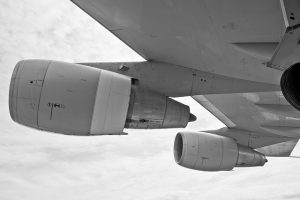
Given its strength, you may assume that steel is one of the most common materials used in the construction of airplanes. Depending on the type, it can have a tensile strength of over 150,000 pounds per square inch (PSI), making it incredibly strong. Steel, however, only accounts for about 10% to 13% of a typical airplane’s weight. So, why aren’t airplanes made mostly of steel?
Weight
It may be strong, but steel is also heavy. Steel has a density of approximately 7.85 g/cm³, whereas aluminum has a density of approximately 2.70 g/cm³. As a result, steel weighs about three times as much as aluminum. If airplanes were made mostly of steel, all of this extra weight would have serious repercussions. It would make them consume more fuel, require longer runways for takeoffs and landings, shorten their range, and reduce their payload capacity.
Corrosion
Another reason airplanes aren’t made mostly of steel is because of corrosion. Steel is an iron alloy that can rust and corrode. While some types of steel are protected from this phenomenon, it typically comes at the cost of strength. Stainless steel, for instance, features chromium that protects it from corrosion, but it’s not as strong as high-carbon steel.
Airplanes operate in harsh conditions. They are regularly exposed to heat, cold, humidity, strong winds and even salt when flying over oceans. Steel can corrode in these conditions, but other aerospace materials like composites and aluminum can withstand the harsh conditions of high-altitude flights.
Manufacturing
Because it’s so strong, steel is more difficult to work with than other aerospace materials. It requires more powerful machines and labor that, ultimately, adds to the cost of production. Aluminum is a softer material that’s easier to shape and bend.
In addition to being softer, aluminum costs less per pound than steel. It’s easier to transport — due primarily to its lightweight properties — so aluminum usually costs less than steel. As a result, using aluminum in airplanes results in a lower cost of production.
Airplanes Still Contain Steel
It may not be the primary material used in their construction, but airplanes still contain steel. It’s typically used for parts that require high strength and heat resistance. Landing gear components and engine components, for example, are often made of steel. Fuselages, on the other hand, are typically made of lighter materials like aerospace-grade aluminum or composites.



